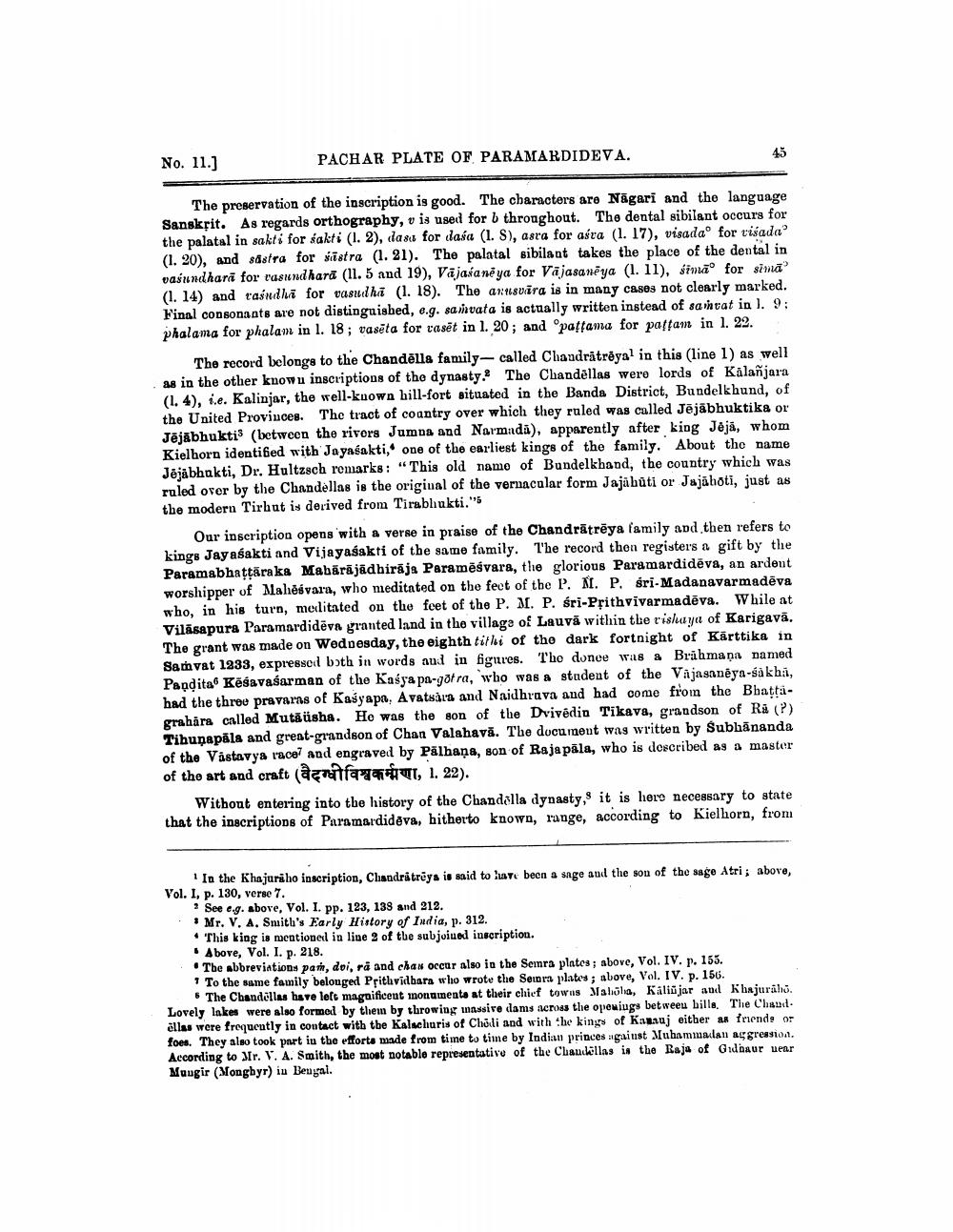________________
No. 11.)
PACHAR PLATE OF PARAMARDIDEVA.
45
The preservation of the inscription is good. The characters are Nägari and the language Sanskrit. As regards orthography, v is used for b throughout. The dental sibilant occurs for the palatal in sakti for sakti (1.2), dasu for daía (1. S), asra for aíra (1. 17), visadao for risada (1. 20), and sõstra for sāstra (1.21). The palatal sibilant takes the place of the dental in vasundhara for vasundhara (11. 5 and 19), Vå jakaneya for Väjasaneya (1. 11), simão for sīmā (1. 14) and tasudhi for vasudha (1. 18). The antsvāra is in many cases not clearly marked. Final consonants are not distinguished, e.g. sa invata is actually written instead of samrat in ). 9: phalama for phalam in l. 18; vasēta for rasēt in 1. 20; and pattama for paffan in 1. 22.
The record belongs to the Chandella family-called Chandrätröyal in this (line 1) as well as in the other knowu inscriptions of the dynasty. The Chandēllas were lords of Kalanjara (1.4), s.e. Kalinjar, the well-kuown hill-fort situated in the Bands District, Bundelkhund, of the United Provinces. The tract of coantry over which they ruled was called Jējābhuktika or Jējābhukti (between the rivers Jumpa and Narmadā), apparently after king Jėja, whom Kielhorn identified with Jayasakti, one of the earliest kings of the family. About the name Jējābhakti, Dr. Hultzsch remarks: "This old name of Bundelkhand, the country which was ruled over by the Chandellas is the original of the vernacular form Jajābūti or Jajāboti, just as the modern Tirhut is derived from Tirabhukti.''
Our inscription opens with a verse in praise of the Chandrātrēya family and then refers to kings Jayasakti and Vijayasakti of the same family. The record then registers a gift by the Paramabhattāraka Mabäräjādbirāja Paramėśvara, the glorious Paramardidēva, an ardent worshipper of Malèsvara, who meditated on the feet of the P. M. P. sri-Madanavarmadēva who, in his turn, meditated on the feet of the P. M. P. śri-Pțithvivarmadēva. While at Vilāsapura Paramardidēva granted land in the village of Lauvā within the rishuya of Karigavā. The grant was made on Wednesday, the eighth titli of the dark fortnight of Kärttika in Samvat 1233, expressed both in words and in figures. The donee was a Brāhmaṇa named Pandita Kēšavašarman of the Kaśya pa-göt ra, who was a student of the Vajasaneya-sakha, had the three pravaras of Kaśyapa, Avatsåra and Naidhrava and had come from the Bhattagrahāra called Mutäüsha. He was the son of the Dvivėdin Tikava, grandson of Ra (?)
Tibunapäla and great-grandson of Chan Valahavă. The document was written by Subhānanda of the Vastavya race and engraved by Palhaņa, son of Raja päla, who is described as a master of the art and craft (àcratar , 1. 22).
Without entering into the history of the Chandalla dynasty, it is here necessary to state that the inscriptions of Paramardidēva, hitherto knowa, range, according to Kielhorn, from
In the Khajuriho inscription, Chandritreys is said to have been a sage and the son of the sage Atri; above, Vol. I, p. 130, verse 7.
? See e.g. above, Vol. I. pp. 123, 139 and 212.
Mr. V. A. Smith's Early History of India, p. 312. • This king is mentioned in line 3 of the subjoiue inscription.
Above, Vol. I. p. 218. • The abbreviations par, doi, rå and chas occur also in the Semra plates; above, Vol. IV. p. 155. 1 To the same family belonged Prithvidbara who wrote the Seins plates; above, Vol. IV. p. 156.
* The Chandellas have left magnificent monuments at their chief towns Mahöla, Käliajar an Khajuraho Lovely lakes were also formoil by them by throwing massive dams across the opowiugs betweeu bills. The Chand ellas were frequently in contact with the Kalschuris of Chôdi and with the kings of Kanuj either as friends or foes. They also took part in the efforts made from time to time by Indian princes against Muhammadan aggression. According to Mr. V. A. Smith, the most notable representative of the Chancillas in the Raja of Gdaur uear Muugir (Hongbyr) in Bengal.




